|
|

|
SONORAN WHIPSNAKE Coluber bilineatus
|
DESCRIPTION:
A long (up to 1,778 mm or 70" in total length), slender snake with blue-gray to gray-green coloration on the neck grading to yellow-green at mid body and gray-brown toward the tail. |

|
SPECKLED RATTLESNAKE
Crotalus mitchellii
|
DESCRIPTION:
A large rattlesnake (up to 1,295 mm or 51" in total length excluding rattle) with extremely variable coloration. Specimens from the majority if its range in Arizona are rusty tan or dull pinkish-brown. |
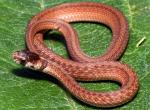
|
Storeria dekayi texana - Texas Brownsnake
|
DESCRIPTION:
The Texas Brown Snake is a very common snake found throughout Harris County, and is highly variable in color, ranging from browns to tans and even brick reds. The color of Texas Brown Snakes is fairly even, though, with the exception of a faint lighter stripe down the middle of the back.
|

|
STRIPED WHIPSNAKE Coluber taeniatus
|
DESCRIPTION:
A long (up to 1,652 mm or 65" in total length), slender, dark brown, gray, or black snake with a prominent light stripe running the length of the body along each upper side. |

|
TERRESTRIAL GARTERSNAKE
Thamnophis elegans
|
DESCRIPTION:
A medium to large (up to 900 mm or 36" in total length) gray, brown, or orange-brown snake with a single cream colored stripe down the midline of the back (dorsal stripe). |

|
Thamnophis couchii - Sierra Gartersnake
|
Nonvenomous
Gartersnakes have toxins in their saliva which can be deadly to their prey and their bite might produce an unpleasant reaction in humans, but they are not considered dangerous to humans. |
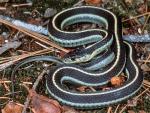
|
Thamnophis elegans elegans - Mountain Gartersnake
|
Nonvenomous
Gartersnakes have toxins in their saliva which can be deadly to their prey and their bite might produce an unpleasant reaction in humans, but they are not considered dangerous to humans. |
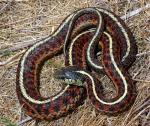
|
Thamnophis elegans terrestris - Coast Gartersnake
|
Nonvenomous
Gartersnakes have toxins in their saliva which can be deadly to their prey and their bite might produce an unpleasant reaction in humans, but they are not considered dangerous to humans. |
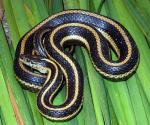
|
Thamnophis gigas - Giant Gartersnake
|
Nonvenomous
Gartersnakes have toxins in their saliva which can be deadly to their prey and their bite might produce an unpleasant reaction in humans, but they are not considered dangerous to humans. |
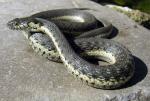
|
Thamnophis hammondii - Two-striped Gartersnake
|
Nonvenomous
Gartersnakes have toxins in their saliva which can be deadly to their prey and their bite might produce an unpleasant reaction in humans, but they are not considered dangerous to humans. |
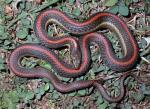
|
Thamnophis ordinoides - Northwestern Gartersnake
|
Nonvenomous
Gartersnakes have toxins in their saliva which can be deadly to their prey and their bite might produce an unpleasant reaction in humans, but they are not considered dangerous to humans. |

|
Thamnophis sirtalis concinnus - Red-spotted Gartersnake
|
DESCRIPTION:
The Garter snake is a Colubrid snake genus (Thamnophis) common across North America, ranging from Alaska and Canada to Central America. It is the single most widely distributed genus of reptile in North America[citation needed]. The garter snake is also the Massachusetts state reptile. |
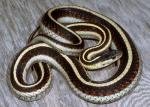
|
Thamnophis sirtalis fitchi - Valley Gartersnake
|
Nonvenomous
Gartersnakes have toxins in their saliva which can be deadly to their prey and their bite might produce an unpleasant reaction in humans, but they are not considered dangerous to humans. |

|
TIGER RATTLESNAKE Crotalus tigris
|
DESCRIPTION:
A medium sized rattlesnake (up to 885 mm or 35" in total length excluding rattle). Base coloration is variable (even within local populations). Most specimens are either blue-gray or orange-brown. There is often an infusion of peach or orange coloration on the lower sides of the body. |
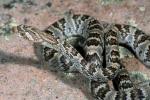
|
Trimorphodon lambda - Sonoran Lyresnake
|
Mildly Venomous
One of the larger rear-fanged snakes, but considered harmless to humans, but handle with caution, as some people have had unpleasant reactions to this snake's bite. |
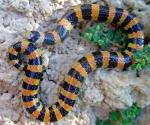
|
VARIABLE SANDSNAKE Chilomeniscus stramineus
|
DESCRIPTION:
A small (up to 285 mm or 11" in total length), stout-bodied snake with dark brown or black saddles on an orange dorsum. The orange dorsal coloration grades into cream on the lower sides. |
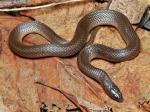
|
Virginia striatula - Rough Earth Snake
|
Description:
The rough earth snake is a small, brown, unpatterned snake with lightly keeled scales (which gives it its common name), and a light colored underside. |
|
|